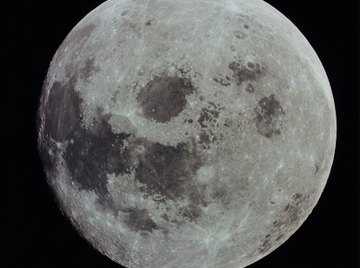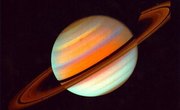
Over the last 50 years, the term satellite has come to be used to describe the man-made satellites launched into orbit for communication and broadcasting purposes, but the term actually refers to any object found to orbit around a planet. Referred to as natural satellites or moons, more than 150 such bodies orbit around planets in the solar system. Just as our moon orbits Earth, satellites have been observed orbiting five other planets: Mars, Jupiter, Saturn, Uranus and Neptune.
Mars
The planet closest to Earth with known satellites is Mars. Named for the Roman god of war, Mars is orbited by two moons, Deimos and Phobos. Discovered by American astronomer Asaph Hall in 1877, Deimos and Phobos are theorized to be caught asteroids, asteroid that have passed closely enough to a planet to be caught in its orbit. At only 12 and 22 kilometers in diameter, Demois and Phobos are some of the smallest satellites in the solar system.
Jupiter
With over 60 moons and satellites, Jupiter is not only the largest planet in the solar system, but also boasts the most moons in its orbit. Four moons, the Galilean Satellites, were first observed in 1610 by Galileo, and they include:
- Io
- Europa
- Ganymede
- Callisto
Ganymede, measuring more than 5,200 kilometers in diameter, is the largest satellite in the solar system. At 4,800 kilometers in diameter, Callisto is the second-largest of Jupiter’s moons, and like Io and Europa, was named after human women in mythology who had love affairs with the Roman god Jupiter.
Saturn
Known for its rings, Saturn also has more than 50 named satellites. The Roman equivalent of Cronos, the father of Zeus, Saturn is the god of agriculture, and the planet named for him was first observed with a telescope by Galileo in 1610. The major moons of Saturn include:
- Mimas
- Enceladus
- Tethys
- Dione
- Rhea
- Titan
- Hyperion
- Iapetus
- Phoebe
The largest moon, Titan measures over 5,000 kilometers in diameter and was first observed by Dutch astronomer Christiaan Huygens in 1655.
Uranus
The seventh planet from the sun, Uranus, has 27 named satellites, including five major satellites named Miranda, Ariel, Umbriel, Titania and Oberon. Discovered by British astronomer Sir William Herschel in 1787, Titania and Oberon are nearly equal in diameter, both measuring between 1,500 and 1,600 kilometers. Ariel and Umbriel, discovered by William Lassel in 1851, are also close in diameter at just over 1,100 kilometers each. Finally, Miranda was first observed by Gerard Kuiper in 1948 and has a diameter of nearly 500 kilometers.
Neptune
Named for the Roman god of the sea, Neptune is the furthest planet from the sun and has 13 named satellites. The three major Neptunian satellites, Proteus, Nereid and Triton, range in diameter from 340 to 2,700 kilometers. Triton, the largest of the three, was the first discovered in 1846 by William Lassel, the same astronomer who would later discover the Uranian satellites of Ariel and Umbriel. In 1949, Gerard Kuiper, who also discovered a Uranian satellite, was the first to observe Nereid, named for sea nymphs in mythology. Most recently discovered by Voyager 2 in 1989, the satellite Proteus measures 418 kilometers.
References
About the Author
Jennifer Hayes began writing professionally in 2010. Previously published online, Hayes has written a series of crafting tutorials with an emphasis on green crafting and creativity on a budget. She attended Southern Methodist University in Dallas, Texas, where she studied English and art.
Photo Credits
NASA/Photodisc/Getty Images
